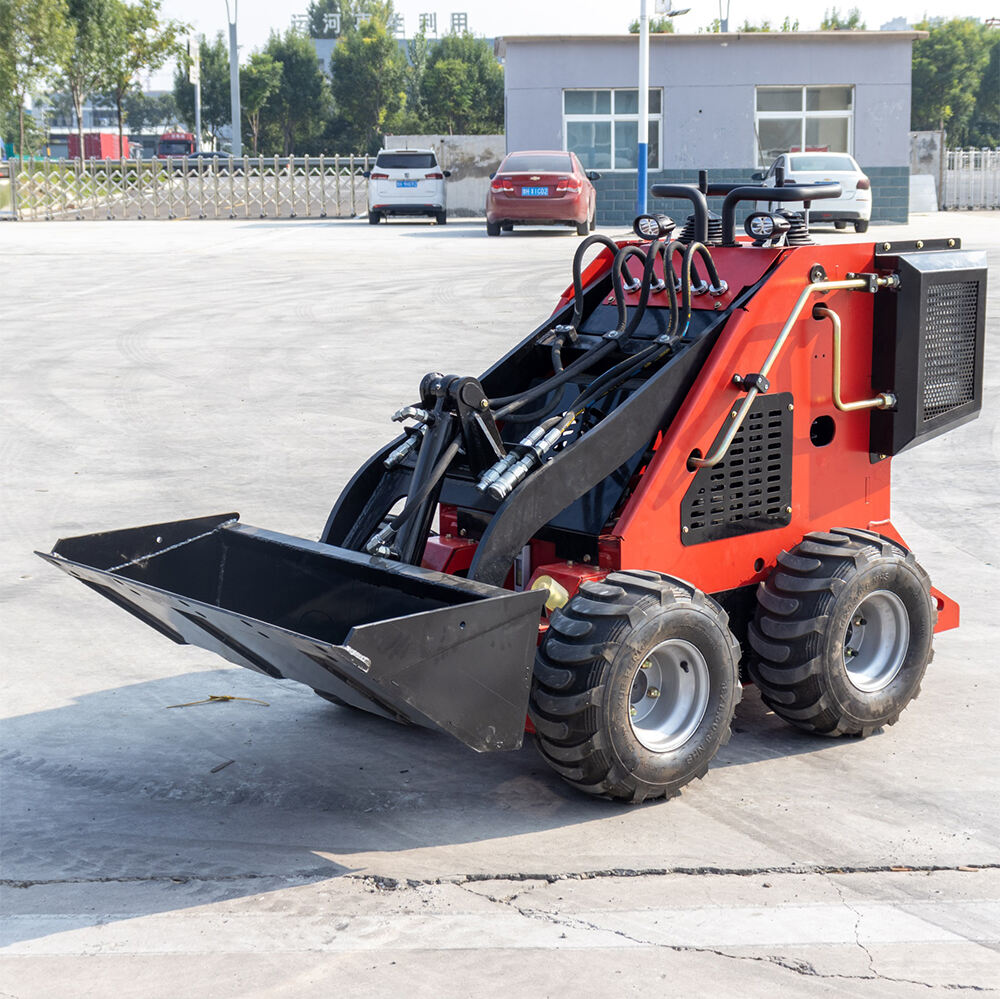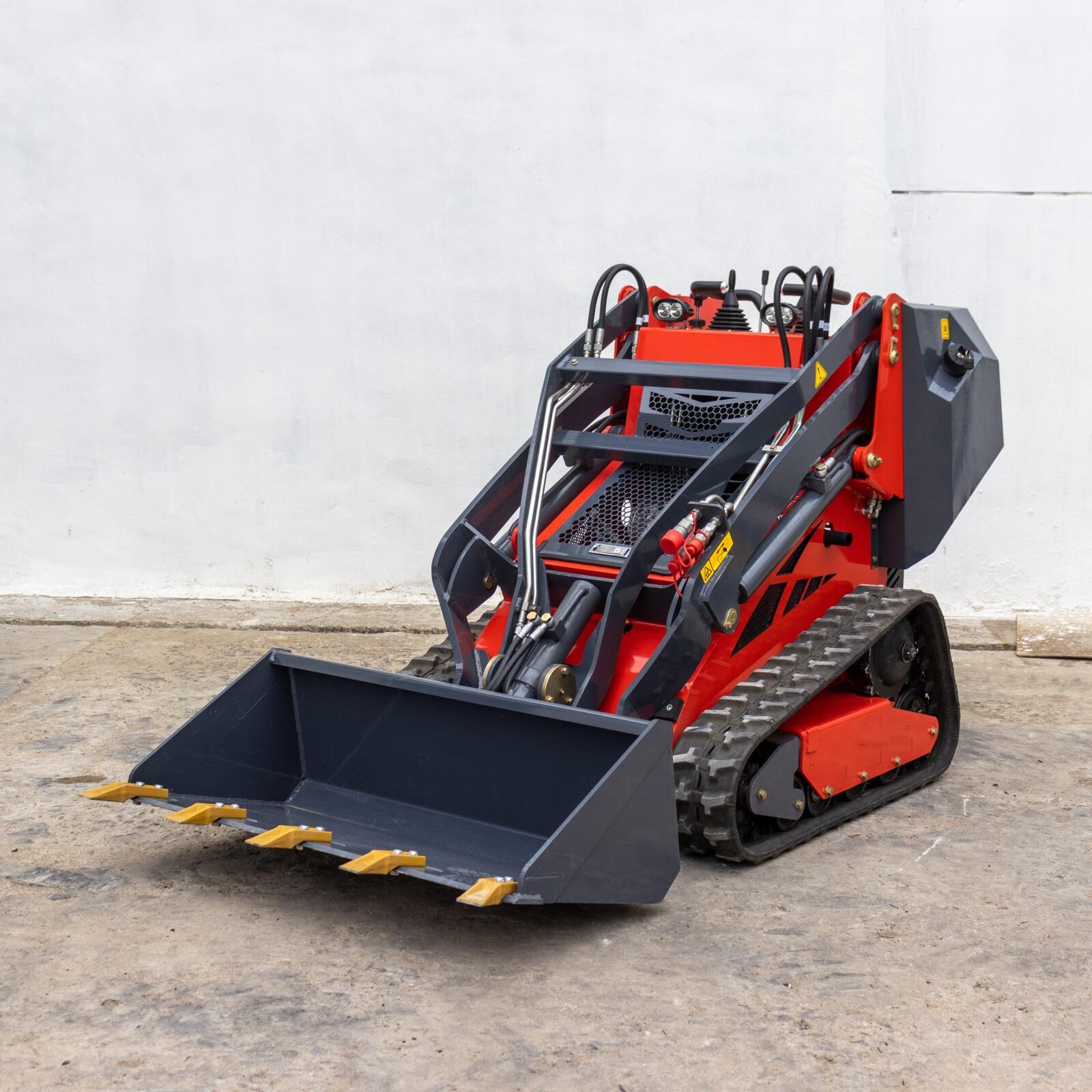Enhance Operations with Versatile Skid Steer Loaders
Key Benefits of Versatile Skid Steer Loaders
Enhanced Maneuverability in Tight Spaces
The compact size of skid steer loaders makes them ideal for getting around tight spaces and cramped job sites. Construction crews working in city environments find this especially helpful when dealing with limited room to maneuver equipment. What really sets these machines apart is their special four wheel steering setup that lets them turn all the way around in place. This means operators can work efficiently even in super tight spots without having to back up constantly. Plus, since they take up so little ground space but still pack serious hydraulic power, workers can switch attachments quickly and get back to work faster. The combination of mobility and strength translates directly into better productivity across most construction sites.
Multi-Attachment Versatility for Diverse Tasks
Skid steer loaders come with the ability to attach different tools such as buckets, forks, and grapples which makes them incredibly versatile machines. With these attachments, they can handle all sorts of jobs including digging, lifting materials, and even grading surfaces. This means construction sites don't need so many different machines sitting around, cutting down costs significantly. When workers switch between attachments quickly during the day, it saves hours of downtime compared to having separate equipment for each task. Contractors find this particularly helpful when trying to stick to tight project timelines without going over budget constraints.
Fuel Efficiency and Cost-Effective Operation
Today's skid steer loaders come equipped with engines that burn less fuel, cutting down on running expenses without sacrificing power output. According to field tests conducted by equipment manufacturers, businesses can actually pocket thousands over time by opting for these efficient machines, particularly where they're used extensively throughout the day. What makes them even more attractive is their lower maintenance bill too. With fewer components wearing out compared to bigger machines, operators find themselves spending less time repairing and more time working. For farms and construction sites alike, this combination of fuel savings and reliability makes skid steers worth every penny invested.
Operator Comfort and Safety Features
Manufacturers have really stepped up their game when it comes to skid steer design lately, focusing heavily on both comfort and safety aspects. The newer models now include things like properly contoured seats that reduce fatigue, adjustable armrests that can be moved around depending on the job, plus climate control systems that keep operators comfortable even during long shifts outside. When talking about safety, companies aren't just paying lip service anymore. Most machines come standard with ROPS frames that protect against rollovers, while better cab visibility helps workers see what's going on around them without constantly twisting their necks. Another big improvement worth mentioning is how much easier these machines are to operate for newcomers. Controls are laid out logically within reach, and the overall design philosophy seems to anticipate common mistakes before they happen, which cuts down significantly on training time for anyone picking up the machine for the first time.
Top Applications for Skid Steer Loaders in Construction and Agriculture
Excavation and Material Handling on Urban Job Sites
In city construction zones where room is at a premium, skid steer loaders shine. These little beasts pack a punch despite their small footprint, typically around 5 feet wide, which lets them squeeze through narrow alleys and between buildings that bigger machinery simply cannot access. They handle all sorts of digging jobs and move stuff around quickly something those massive excavators just cant manage in cramped quarters. On many urban projects, these machines keep things moving forward because they dont get stuck waiting for someone to clear a path. What really makes them stand out though is how they swap out attachments. Just bolt on a bucket for hauling gravel or switch to an auger for drilling holes, and suddenly this one machine becomes whatever tool the job needs. Contractors love this flexibility when working on everything from pouring foundations to laying pipes underground.
Landscaping and Snow Removal Capabilities
Skid steer loaders have a small footprint and can do almost anything, which makes them great for landscaping work around properties. They handle things like leveling ground, laying down sod, and cleaning up after jobs without much trouble. When winter hits hard in snowy areas, these little workhorses become absolutely necessary for getting rid of snow fast. Most folks attach either plows or blowers depending on what needs doing, so driveways and roadways stay clear despite all that white stuff piling up. What really stands out is how easy it is to swap out attachments between seasons. A grapple one day, a blade the next, and suddenly the same machine can tackle both garden prep and snow cleanup. This kind of flexibility means crews don't need separate equipment for each job, saving money on maintenance and storage while still getting everything done efficiently.
Agricultural Uses: From Barns to Field Maintenance
On farms across the country, skid steer loaders have become essential tools for countless jobs around the property. These machines can handle everything from moving animal feed to keeping fields in shape, which saves time and backbreaking labor. Farmers love how they attach different implements - think forks for lifting hay bales or special grabs for moving equipment parts. The small footprint makes them perfect for tight spaces inside barns while still being powerful enough to tackle field work. Most operators will tell anyone who asks that these versatile machines handle just about anything on the homestead. From spreading manure to leveling ground for new crops, skid steers cut down on the number of specialized tools needed, making life on the farm run smoother day after day.
Product Highlights: High-Performance Skid Steer Models
HT320 Skid Steer Loader: Compact Power for Confined Spaces
The HT320 Skid Steer Loader was built specifically for tight spaces where bigger machines just won't fit, yet still packs serious lifting power despite its small footprint. On actual job sites, this machine really shines because it handles all sorts of tricky situations without breaking a sweat. The hydraulic system is pretty impressive too, letting operators swap out attachments quickly so they don't waste time waiting around between tasks. Contractors who've worked with the HT320 often mention how much faster their projects get done compared to using traditional equipment. Some even say it takes on work that would normally require renting specialty machinery from the big guys down at the equipment yard.
HT360W Skid Steer Loader: All-Terrain Efficiency
The HT360W Skid Steer Loader was built to handle just about anything thrown at it. Its all terrain abilities make this machine work well on rough ground, muddy fields, or rocky construction sites alike. That's why so many contractors and farmers pick it for their daily operations. The loader stays stable even when going over bumps and hills, something that really matters when moving heavy materials across job sites. What makes the HT360W truly valuable is the quick attachment feature. Switching between different tools takes minutes instead of hours, allowing operators to tackle everything from digging trenches to clearing snow along roadsides. For businesses needing one machine that can do multiple jobs without constant downtime, this loader offers practical solutions day after day.
HT450 Track Loader: Heavy-Duty Hydraulic Performance
Operators who require serious machinery will find the HT450 Track Loader delivers solid hydraulic power that gets the job done when things get tough on site. Built to tackle real weight loads, this machine can lift massive materials needed for big construction jobs without breaking a sweat. What sets it apart? The frame itself is constructed from thick steel plates that don't bend easily, even after years of working through mud, snow, or whatever Mother Nature throws at it. Construction crews have reported getting consistent results day after day, which matters most when deadlines are tight. For anyone looking for reliable equipment that won't let them down during critical lifts, the HT450 remains a top pick among professionals who know quality when they see it.
Maintenance Tips for Maximizing Skid Steer Longevity
Routine Fluid Checks and Filter Replacements
Keeping an eye on fluids and replacing filters regularly makes all the difference when it comes to how long a skid steer loader will last and how well it runs. The engine oil needs checking along with those hydraulic fluids too. If operators skip this step, they're asking for trouble down the road with sudden breakdowns that nobody wants during busy workdays. Most mechanics suggest changing those filters somewhere around 200 hours mark, maybe give or take depending on what kind of dirt and dust gets kicked up at the job site. Neglecting these basic maintenance steps tends to cost companies big time later on through expensive fixes and shorter equipment life spans. Anyone who owns heavy machinery knows this stuff matters for both wallet health and getting the job done without constant interruptions.
Hydraulic System Care for Attachment Compatibility
Taking good care of the hydraulic system keeps skid steer loaders working well across all those different attachments they need to handle. When someone does regular checks on these systems, it stops leaks before they become problems and keeps everything running efficiently. That matters because nobody wants their machine stuck when switching from one attachment to another during work. What actually needs doing? Check those hoses regularly, make sure all the fittings are tight, and change out the hydraulic fluid according to what the manual says. Some folks forget about this basic stuff until something breaks down. But when hydraulics stay in top shape, operators find themselves getting through tasks faster without unnecessary delays. This makes all the difference when working on jobs where time really counts and versatility is what makes skid steers so valuable in so many construction scenarios.
Preventing Wear on Tracks or Tires
Regular checking of tracks and tires matters a lot for catching wear before it gets bad, so we can rotate them or replace when needed before bigger problems happen. Dirt buildup on skid steers does more than just look messy it actually wears down those rubber components faster and makes the machine slip around more than it should. When doing maintenance work, don't forget to check how everything lines up properly because misalignment leads to uneven tire wear across the board. This kind of basic attention saves money in the long run since nobody wants to keep buying new parts all the time. Most operators find that sticking with these simple checks month after month keeps their equipment running longer and working better through tough jobs day after day.



